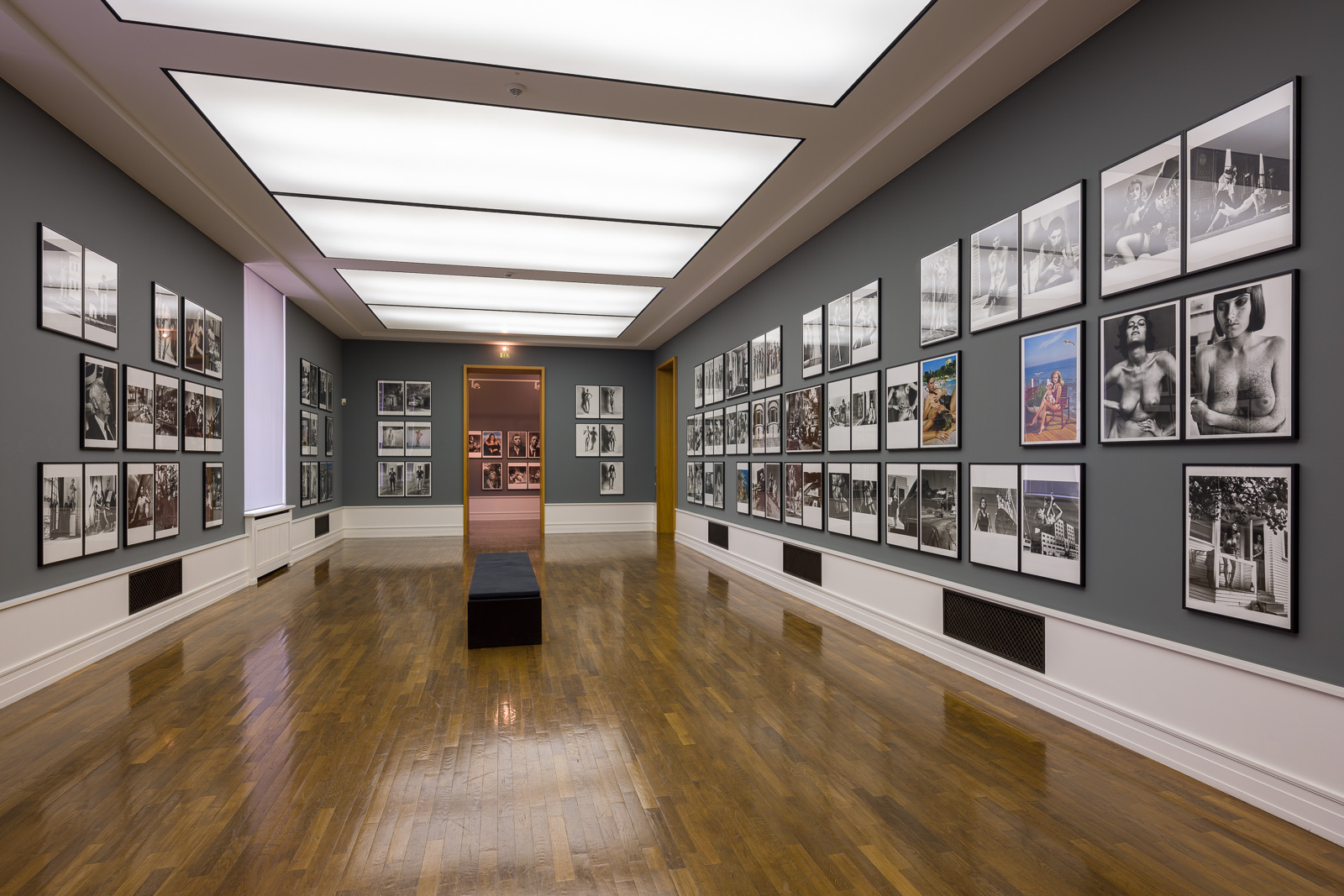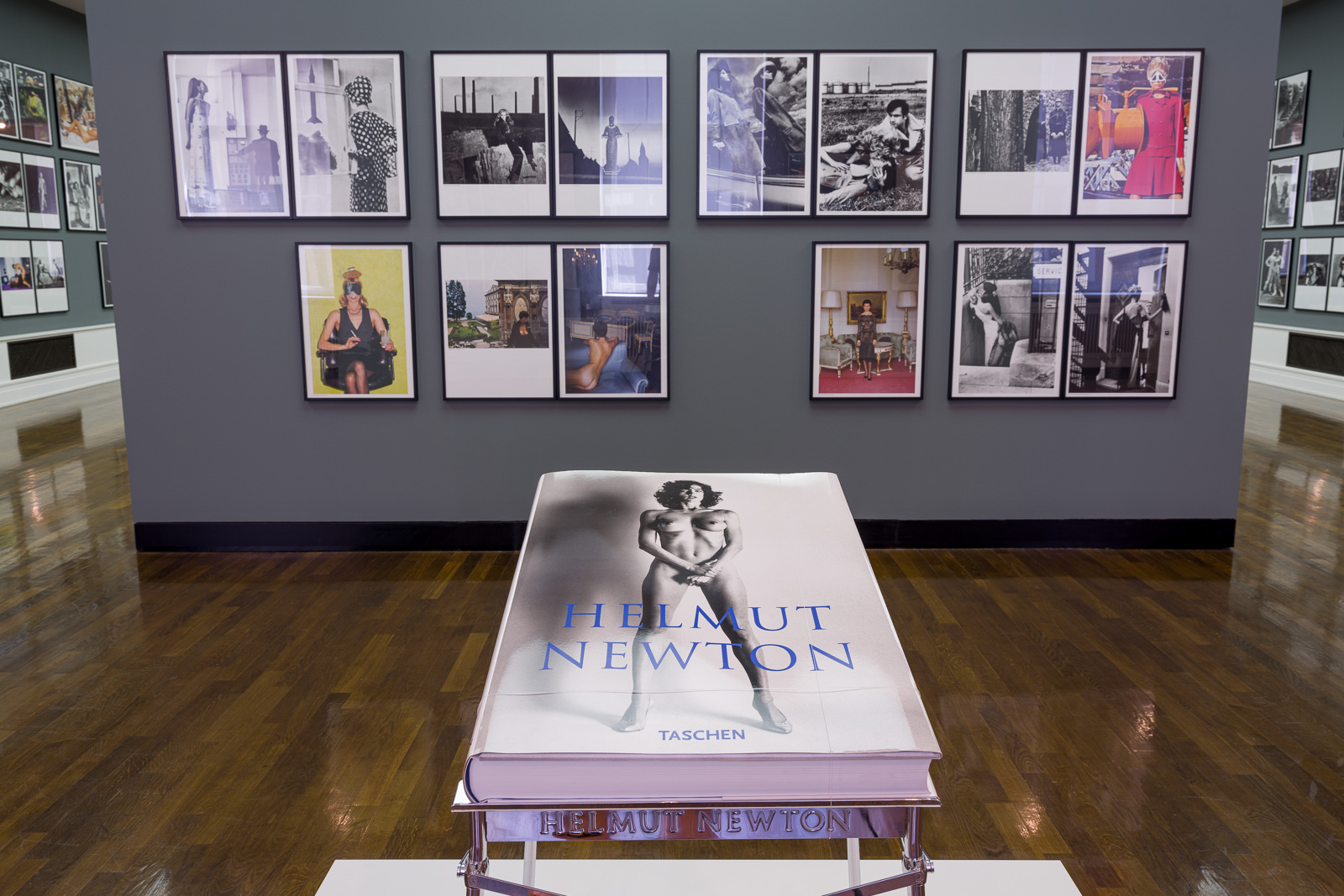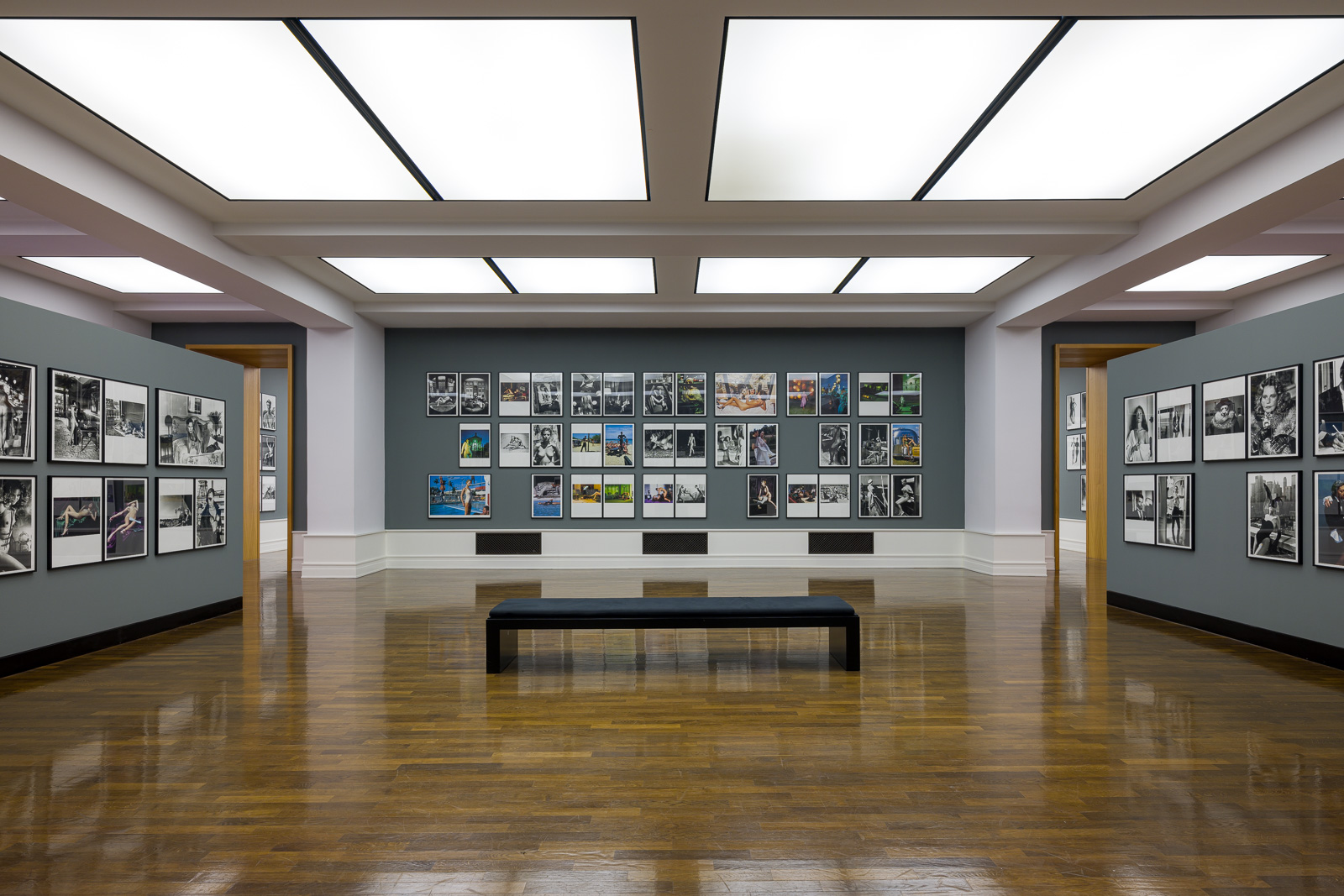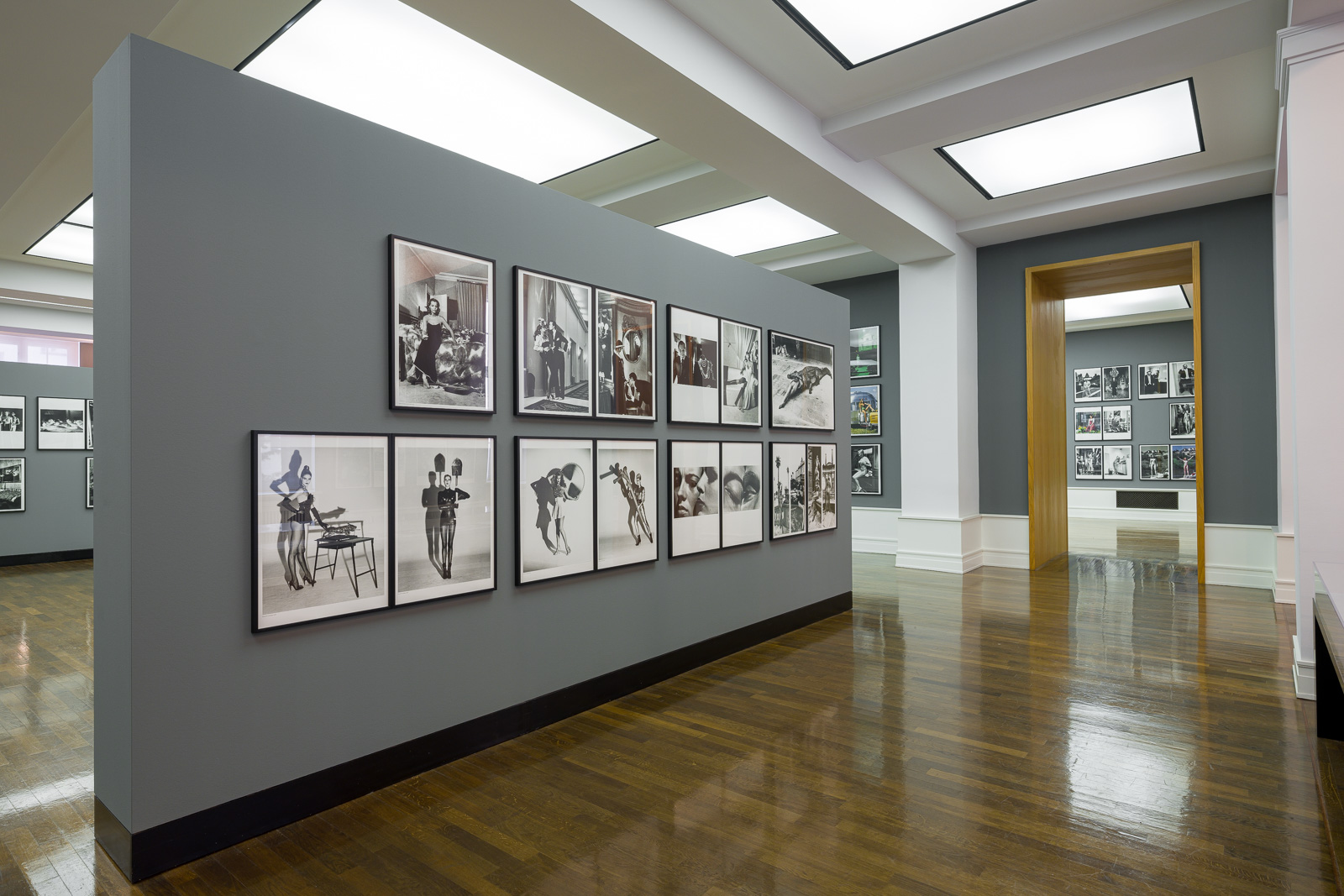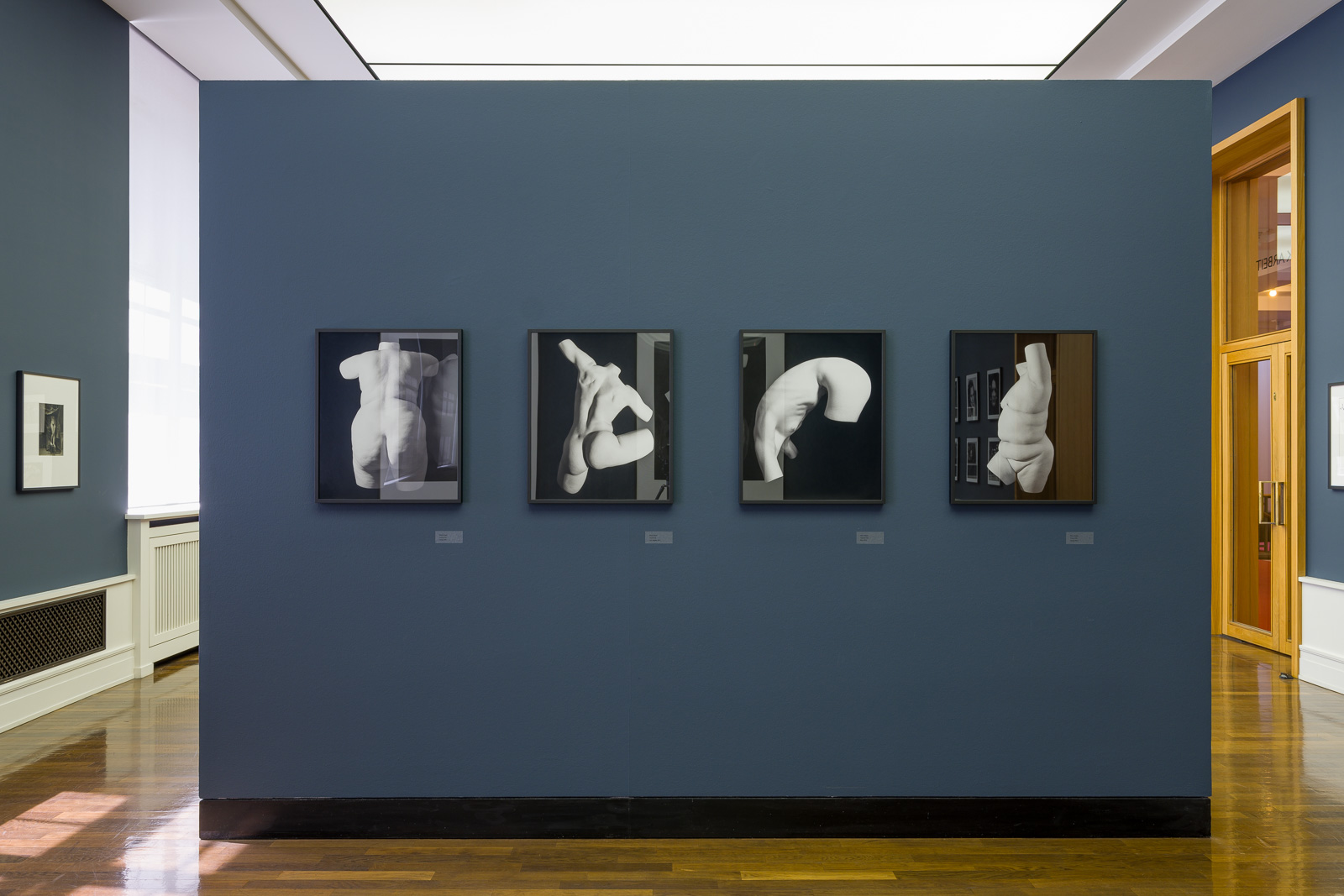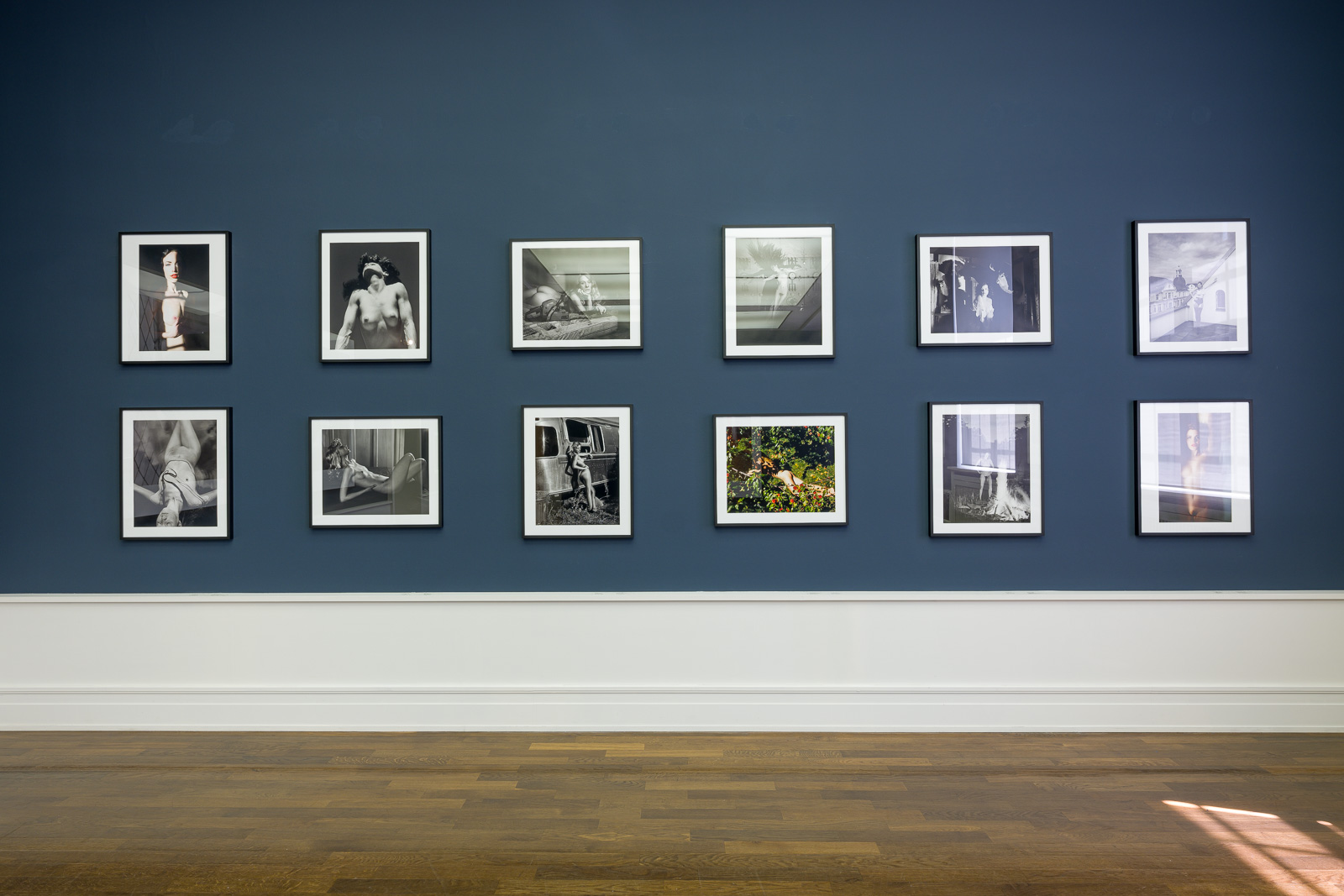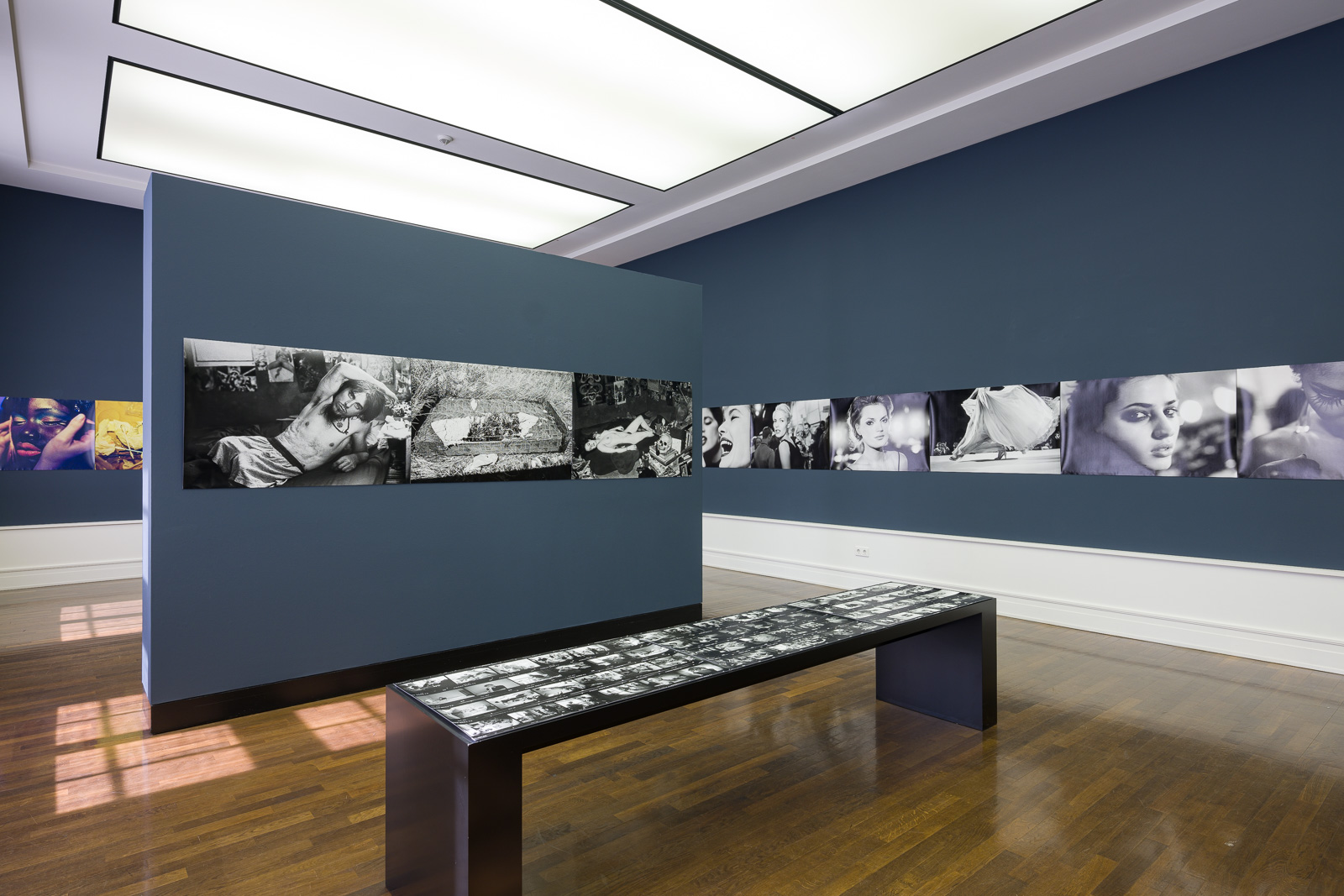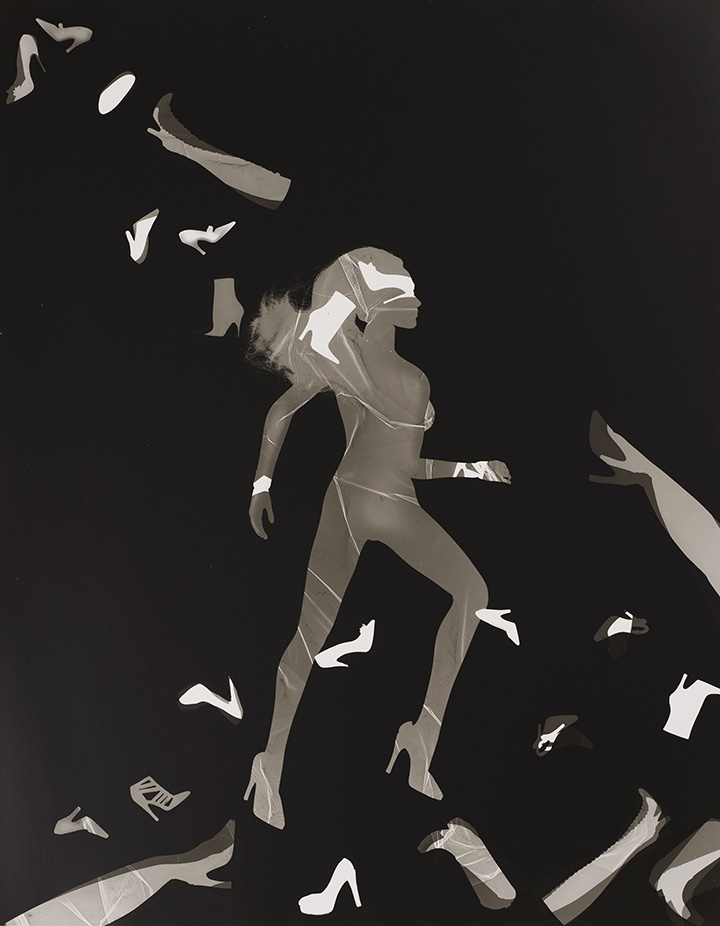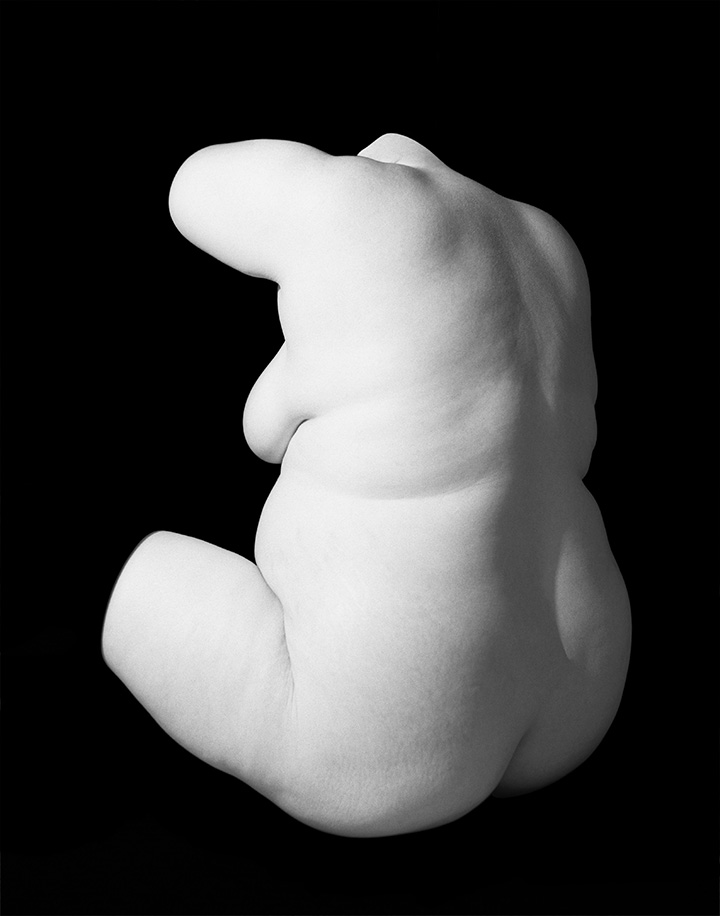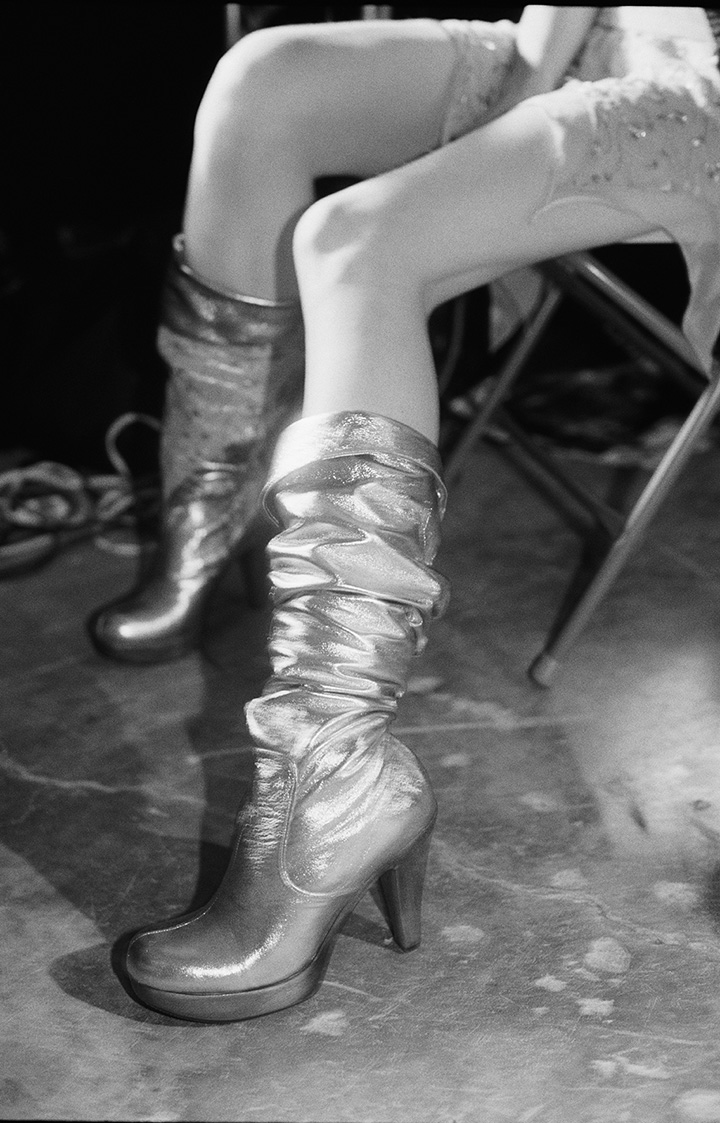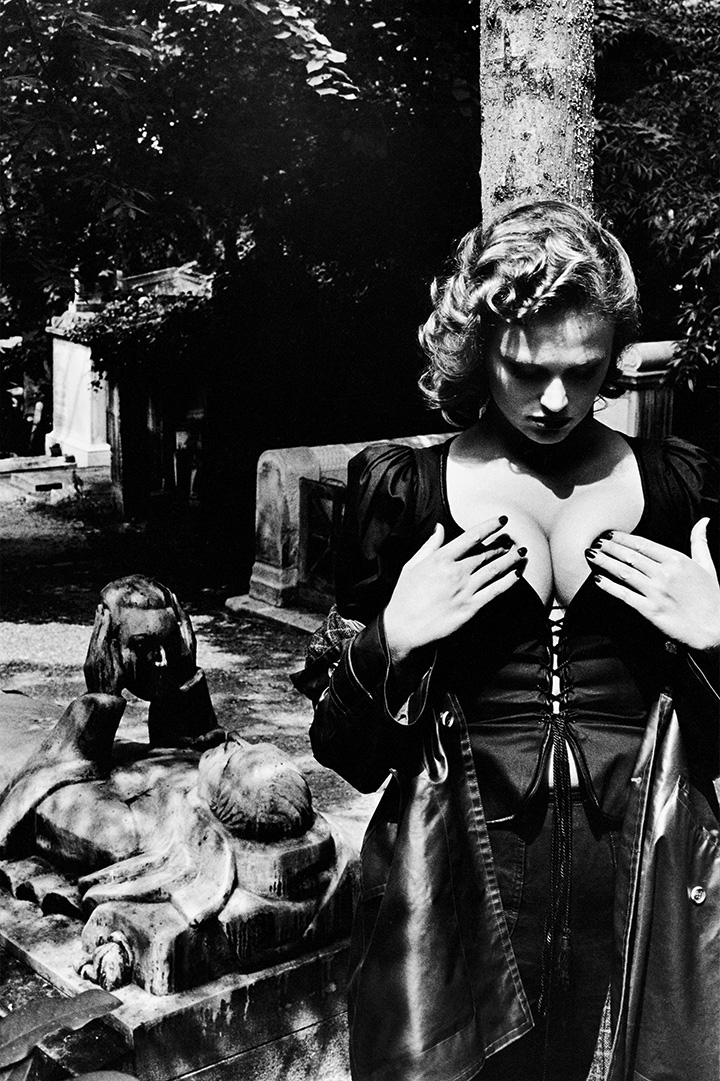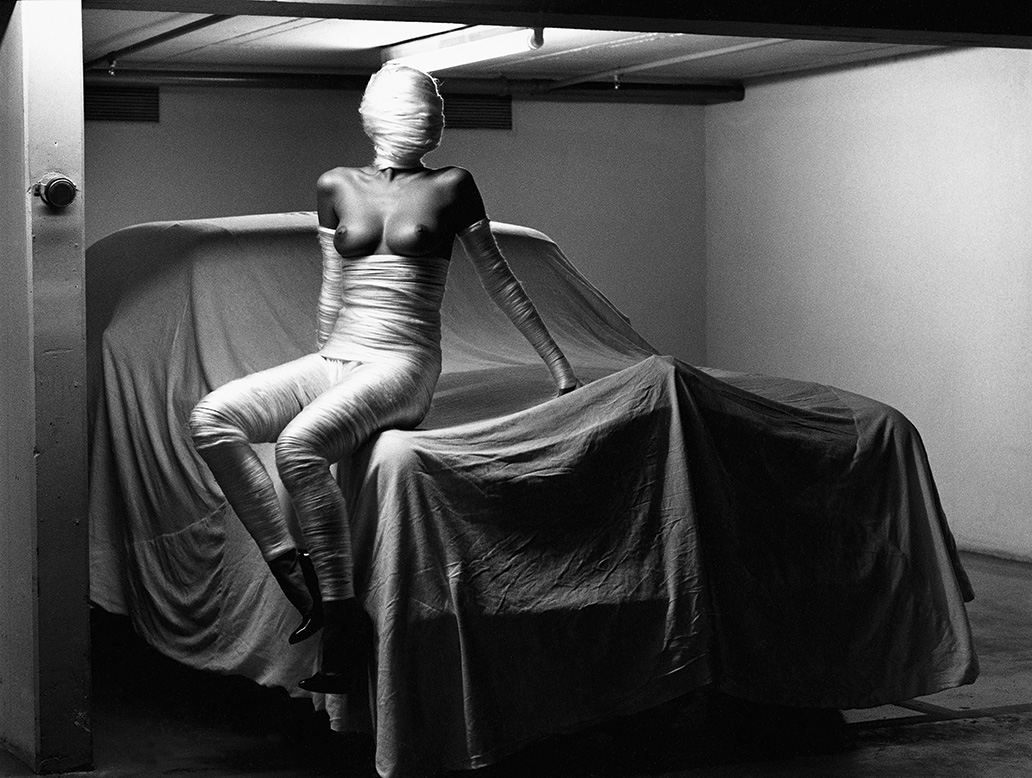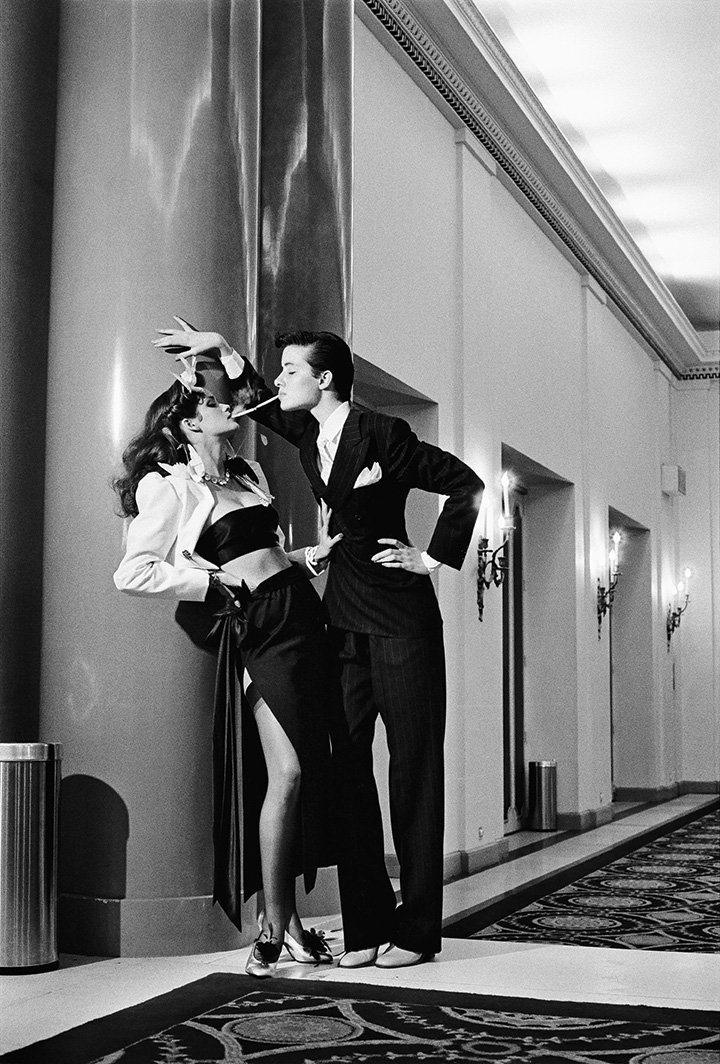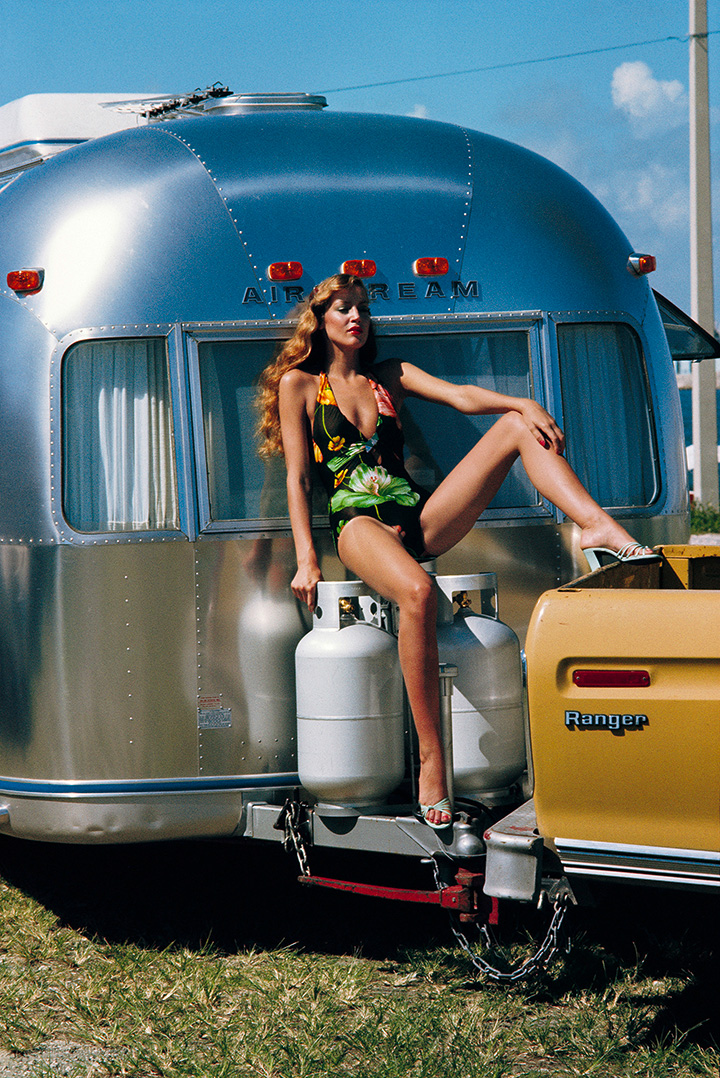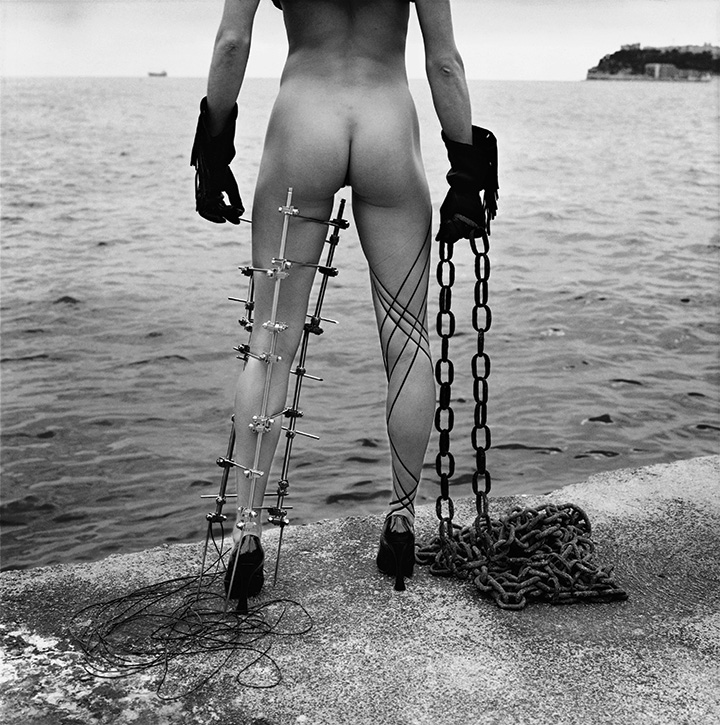Twenty years ago, Taschen published its first monumental art book: Helmut Newton, SUMO. It came out in 1999 with a print run of 10,000 copies and delivered with a metal stand designed by Philippe Starck.
Now, the Helmut Newton Foundation organizes an unconventional yet fitting exhibition dedicated to this legendary publication: the book’s 464 framed pages are hanging on the wall, side by side, in two or three rows, one above the other, in the order of their appearance in the book. In contrast to browsing page-by-page through the book, we could stand in the midst of more than 400 iconic photographs and see everything all at once, his famous nudes, portraits and fashion photographs shot for various magazines. SUMO begins with an introductory autobiographical essay by Helmut Newton. With his words, the photographer takes us on a journey through time – from Berlin to Singapore, Australia, and Paris, where his incomparable career as a fashion photographer began in the early 1960s. Starting in the 1980s, he took also nude and fashion photographs in Hollywood where Newton met three young photography students : Mark Arbeit, George Holz, and Just Loomis, who would assist him with his work in the following years.
This collaboration and friendship now ends in the presentation of Three Boys from Pasadena, about 50 photographs per artist and exhibition room. Mark Arbeit displays life-size photograms of nude female models and small-format photograms of toy dolls which pay homage to Helmut Newton’s passion for collecting such figures. His Torso series refers to statues from classical antiquity as well as Surrealist photographic experiments. George Holz presents a number of his well-known Hollywood portraits which have adorned many covers of well-known magazines, accompanied by more recent nudes. The coexistence of the dressed and undressed, of protagonists who are both pensive and seductive, can also be found in the work of Helmut Newton. Just Loomis, meanwhile, has selected some of his Backstage works to complement his earlier As We Are series. His images reflect his attentive, empathetic view of people, be they children, waitresses, homeless people, or models. With Backstage, he shows us the other side of the glitzy fashion business: the concentration, frenzy, and intense emotional energy of the models which charge the atmosphere behind the catwalk.
For the first time, the exquisite private photo collection of Helmut and June Newton will also be on display. Until a few months ago, this collection was kept in their apartment in Monte Carlo. Hanging in “June’s Room” at the Helmut Newton Foundation, parallel to SUMO and Three Boys from Pasadena, are portraits by August Sander, Brassaï, and Irving Penn, nudes by Man Ray, Robert Mapplethorpe, and Diane Arbus, fashion photos by Horst P. Horst and Richard Avedon; as well as landscapes by Franco Fontana and Peter Beard. In short, the collection holds valuable vintage prints by many of the most important photographers of the 20th century, presented in their original frames.
Selected Works
Opening & Interview
Opening on June 6, 2019
SUMOThree Boys from PasadenaPrivate Photo Collection
Matthias Harder
A legendary photo book in a unique XXL format, a private photo collection, and three of Helmut Newton’s former assistants who have been in the business for a long time – these are the ingredients for the new exhibition at the Helmut Newton Foundation, which will open on 6 June 2019.
Twenty years ago in 1999, Taschen published its first monumental art book: Helmut Newton. SUMO. It came out on the market in the exceptionally large format of 70 x 50 cm with a print run of 10,000 copies, all signed by the photographer and delivered with a metal stand designed by Philippe Starck. Since then, SUMO has rested on that stand in the similarly impressive homes of private collectors, where from time to time one of the poster-sized pages is turned. Shortly after the book’s publication, a copy that had been additionally signed by some of Newton’s world-renowned subjects was sold for over DM 600,000 at a charity auction, adding another superlative by making it the most expensive book of the twentieth century.
Ten years ago in 2009, the Helmut Newton Foundation organized an unconventional yet fitting exhibition dedicated to this legendary publication: the book’s 464 pages were framed and hung on the wall, side by side in three rows, one above the other. In contrast to browsing page-by-page through the book, exhibition visitors could stand in the midst of more than 400 photographs and see everything all at once. This format made it possible to view Newton’s iconic images both individually and in the context of the different periods of their creation, from the 1960s to the 1990s. On the occasion of that exhibition, Taschen published a smaller version of SUMO, which is still available on the book market today.
Now, another ten years later, SUMO will again be presented at the Helmut Newton Foundation. As before, the book’s pages will be arranged above and next to each other, in the order of their appearance in the book. We encounter Newton’s famous Big Nudes and other nude photographs, numerous fashion photographs Newton shot for various editions of Vogue, Elle, Stern, and Vanity Fair, as well as his portraits of famous actors and artists, from Liz Taylor and Jodie Foster to Salvador Dalí and Andy Warhol. Helmut Newton’s work will unfold throughout the space in a way not usually seen at his foundation. Yet even this generous selection of images is only a small excerpt from his colossal body of work, full of timeless elegance and subtle seduction.
The book SUMO begins with an introductory autobiographical essay written in English by Helmut Newton. Like the framed book pages, this text can also be found hanging on a wall in the exhibition. With his words, the photographer takes us on a journey through time – from Berlin, where he was trained by Yva, to Singapore, Australia, and Paris, where his incomparable career began in the early 1960s, particularly with French Vogue. Starting in the 1980s, he started adding nude photographs to his portfolio, which a short time later were followed by numerous portraits, taken especially in Hollywood, where Helmut and June Newton spent several months every year at the Chateau Marmont hotel. It was in California that Newton also met three young photography students: Mark Arbeit, George Holz, and Just Loomis, who would assist him with his work in the following years.
Similar to the exhibition a decade ago in 2009, Newton’s SUMO exhibition will be accompanied by works from these Three Boys from Pasadena. This time however, their works will be shown in different parts of the foundation. Each of these American photographers will have a dedicated space, in which their earlier works which were previously shown and which have been part of the Newton Collection in Berlin for years, will now be joined by new photographs – for a total of more than 50 photographs each per artist and exhibition room. A similar presentation approach was used in another exhibition at the foundation, Guy Bourdin: Image Maker.
Mark Arbeit complements his earlier photos with life-size photograms of nude female models, posing them directly on photosensitive paper before exposing them to light. He also shows small-format photograms of toy dolls, which pay homage to Helmut Newton’s passion for collecting such figures. Helmut Newton’s Private Property, the foundation’s permanent exhibition on the ground floor, includes numerous Barbie dolls from Newton’s private collection, presented on a Memphis-style shelf designed by Ettore Sottsass. For his Torso series, Mark Arbeit covered the arms, legs, and head of his female models with black fabric, so that only their torso is visible in the photograph. Set against a black background, the cropped figures seem to emerge from a void, twisting and turning in sometimes extreme poses. The images make reference to statues from classical antiquity as well as Surrealist photographic experiments.
George Holz, in addition to his black-and-white nudes from the earlier exhibition, now presents a number of his well-known Hollywood portraits in black-and-white and color, including Madonna, Sade, Andy MacDowell, Kirstin Dunst, Jack Nicholson, and Steven Spielberg. Some of these images have adorned the covers and inside pages of well-known magazines. The portraits are accompanied by more recent nudes, some of them taken outdoors in nature. The coexistence of the dressed and undressed, of protagonists who are both pensive and seductive, can also be found in the work of Mark Arbeit and, of course, Helmut Newton. Holz’s work likewise draws attention to the body and the eyes, to poses and beauty, while also seeking to capture the essence of his subject’s true personality. Male and female models find equal footing in his work, which consists of both commissioned and independent projects.
Just Loomis, meanwhile, has selected some of his Backstage works to complement his earlier Americana series. His images reflect his attentive, empathetic view of people, be they children, waitresses, homeless people, or models. Both of these series by Loomis have been accompanied by books published by Hatje Cantz. Shortly after the first Three Boys from Pasadena exhibition at the Helmut Newton Foundation in Berlin, his book As We Are was released. The images, some of which date back to the mid-1970s, build visually on Loomis’s recollections of growing up in his native Reno, Nevada. His more recent publication, Backstage, was presented at a book launch at the Helmut Newton Foundation in 2018, and will now be featured at the foundation again, for the first time in the form of photo prints. With Backstage, Loomis shows us the other side of the glitzy fashion business: the concentration, frenzy, and intense emotional energy of the models which charge the atmosphere behind the catwalk. These portrait-like images have a sense of timelessness about them. Loomis started the series in the 1980s, when he moved to Milan and first discovered the backstage, taking many photographs apart from the actual fashion shows.
These three photographers are now about the same age as Helmut Newton was when he first met them, as students at the Art Center College of Design in Pasadena, California, and took them on as his assistants. Today they are established, commercially successful photographers with their own assistants. In the early 1980s, Newton was commissioned to shoot several portraits – including for Vanity Fair, of personalities such as Michelle Pfeiffer, Jacqueline Bisset, and Debra Winger; and for Playboy, of Nastassja Kinski. To support him in these shoots, he would always take along one of the three young design students from Pasadena. Looking at the work of Arbeit, Holz, and Loomis today, we can detect the influence of Helmut Newton, even though they have each developed their own unique style.
For the first time, the exquisite private photo collection of Helmut and June Newton will also be on display. Until a few months ago, this collection was kept in their apartment in Monte Carlo, and has now come into the care of the Helmut Newton Foundation in Berlin. Hanging in June’s Room at the foundation, parallel to SUMO and Three Boys from Pasadena, are portraits by August Sander, Brassaï, Ralph Gibson, Mary Ellen Mark, Albert Watson, Irving Penn, and George Hurrell. There are also nudes by Man Ray, Robert Mapplethorpe, Henri Cartier-Bresson, Frantisek Drtikol, Diane Arbus, and Chris von Wangenheim; fashion photos by Horst P. Horst, George Hoyningen-Huene, and Richard Avedon; as well as landscapes by Franco Fontana and Peter Beard. In short, the collection holds valuable vintage prints by many of the most important photographers of the 20th century, presented in their original frames. The intimacy of the exhibition space in June’s Room underscores the individuality of the private collection, which was acquired over the course of decades by Helmut and June Newton.
